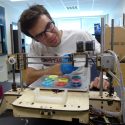Two UW student teams named finalists in national inventors competition
Two University of Wisconsin–Madison undergraduate teams are among only seven finalists for the 2014 National Collegiate Inventors Competition, which honors the latest in student creativity and innovation.

Taylor Fahey (computer engineering, computer science), Charles Haider (chemical engineering) and Cedric Kovacs-Johnson (chemical engineering) are recognized for Spectrom, an on-demand, full-color 3-D printing technology. Their advisor for the project is Tim Osswald, the Kuo K. and Cindy F. Wang professor of mechanical engineering.
Eric Ronning (mechanical engineering) will be representing his invention, the Remex Static Mixer, along with team members Will Doniger (material science and engineering) and Brian Pekron (nuclear engineering). The project advisor is Thomas “Rock” Mackie, director of medical engineering at the Morgridge Institute for Research.
Winners will be announced at the Nov. 17 competition, held annually at the United States Patent and Trademark Office in Alexandria, Virginia. Competitors get the opportunity to network with some of the nation’s foremost innovators while competing for more than $100,000 in cash prizes.
“We’d like to show that color is not just a feature — it enables you to do so much more. Our next steps are about determining what people actually want to make in color, and how we provide the tools for them to use our tool.”
Cedric Kovacs-Johnson
Spectrom is a 3-D printer attachment that dyes clear plastic on demand in a precise, continuous process. The device allows for variable color 3-D printing within a single project, a previously unmet need.
“3-D printing is pretty much a monochromatic industry right now, so you can only print in one color at a time,” says Haider. “What people have done are workaround solutions that don’t solve the true problem at hand.”
“We now know the core technology to color is there. That works,” says Kovacs-Johnson. “We’d like to show that color is not just a feature — it enables you to do so much more. Our next steps are about determining what people actually want to make in color, and how we provide the tools for them to use our tool.”
Simplifying the process of 3-D modeling is crucial to enabling average consumers to create their own products, Haider says. But sometimes the greater need is helping audiences who wouldn’t typically use 3-D printers realize possibilities the technology can bring.
Spectrom is a beneficiary of UW–Madison’s new Discovery to Product (D2P) program that helps projects at the pre-commercialization stage reach marketability. While the group has already won several campus and statewide competitions, the Collegiate Inventors Competition would be the first national honor.
The Remex Static Mixer introduces a new geometry to the standard static mixer design.
A typical static mixer allows for fluids to mix as they move through a cylindrical tube or pipe. The structure blends the liquids as they flow through the tube.
Ronning likens current market options to countertop blenders.
“Blenders are great for whipping up strawberry shakes; however, you can expect you’ll destroy all of your fruit in the process,” Ronning says. “Current static mixers are too violent when mixing delicate fluids. … (M)any industries are stunted by their mixing processes.”
“The most serendipitous innovations come when you’re colliding together two things. In this case, it was a knowledge of both the theory and the practical details to implement it.”
Thomas “Rock” Mackie
Early tests have shown the Remex Static Mixer to require less pressure, almost doubling efficiencies over the current champion on the market.
“It means you can do things you couldn’t otherwise do,” Ronning says. “The hope is that this design can mix reactants that would otherwise be too fragile, like recombinant protein therapies where live cells are mixed together.”
The Remex project was founded on theories about both efficient mixing and the reduction of shear stress for gentler mixing. Determining an optimized shape mathematically was the first step; physically modeling it was another hurdle, says Mackie, the advisor on the project.
“It was pointed out that this mathematical shape was theoretically the best and impossible to make,” Mackie says. “But, in fact, you can make it — with 3-D printers. The most serendipitous innovations come when you’re colliding together two things. In this case, it was a knowledge of both the theory and the practical details to implement it.”
— Courtni Kopietz
Tags: engineering, student awards, technology


